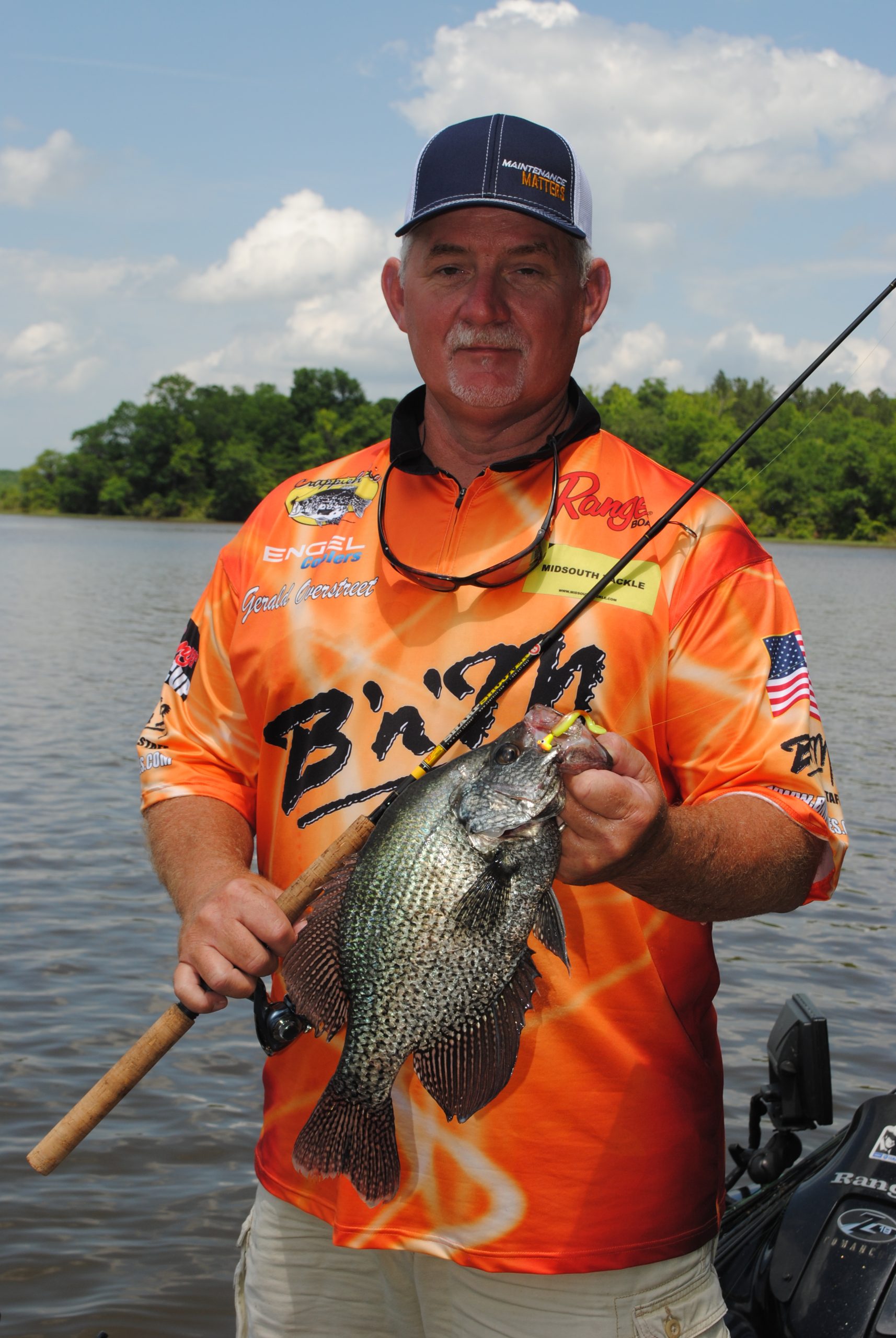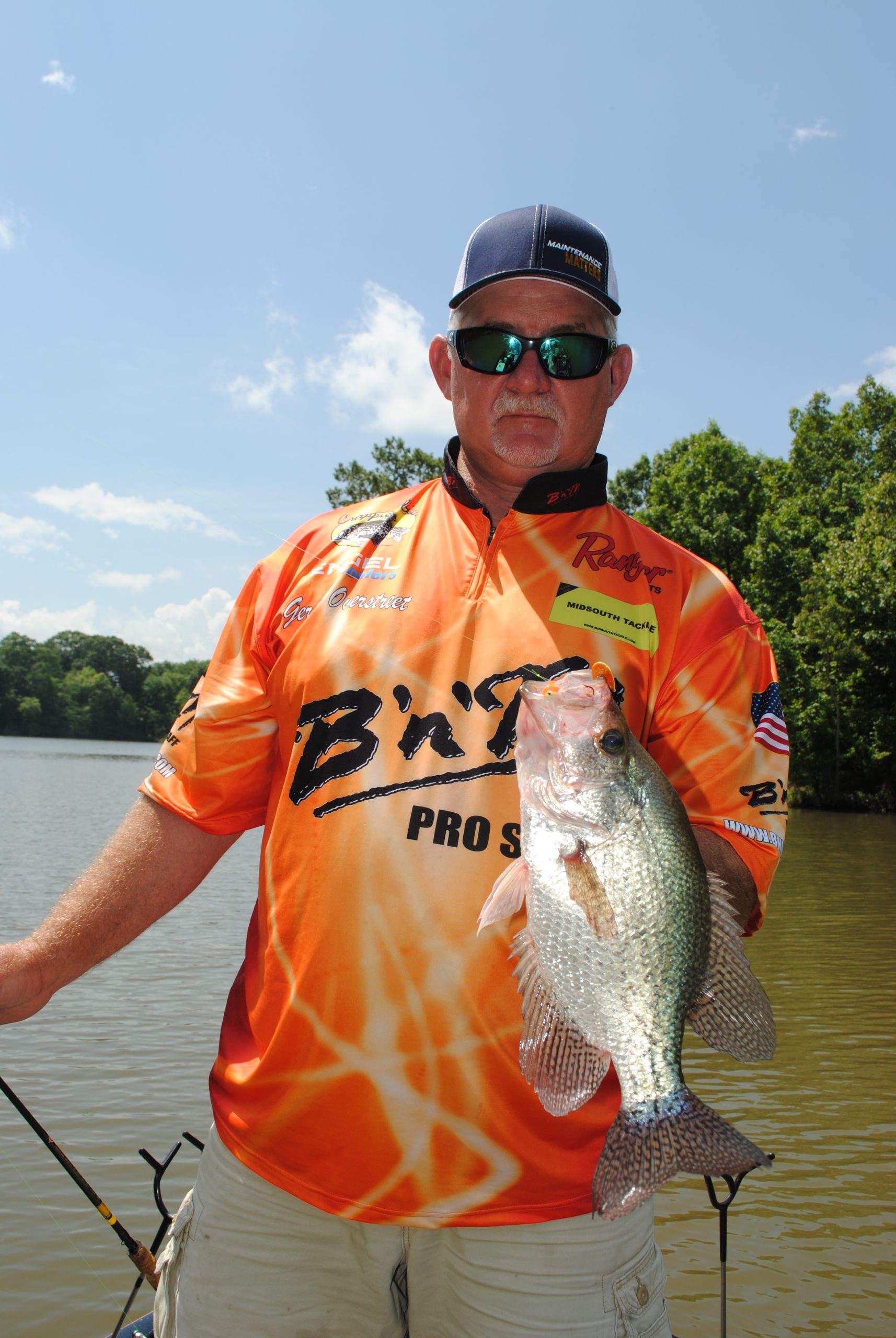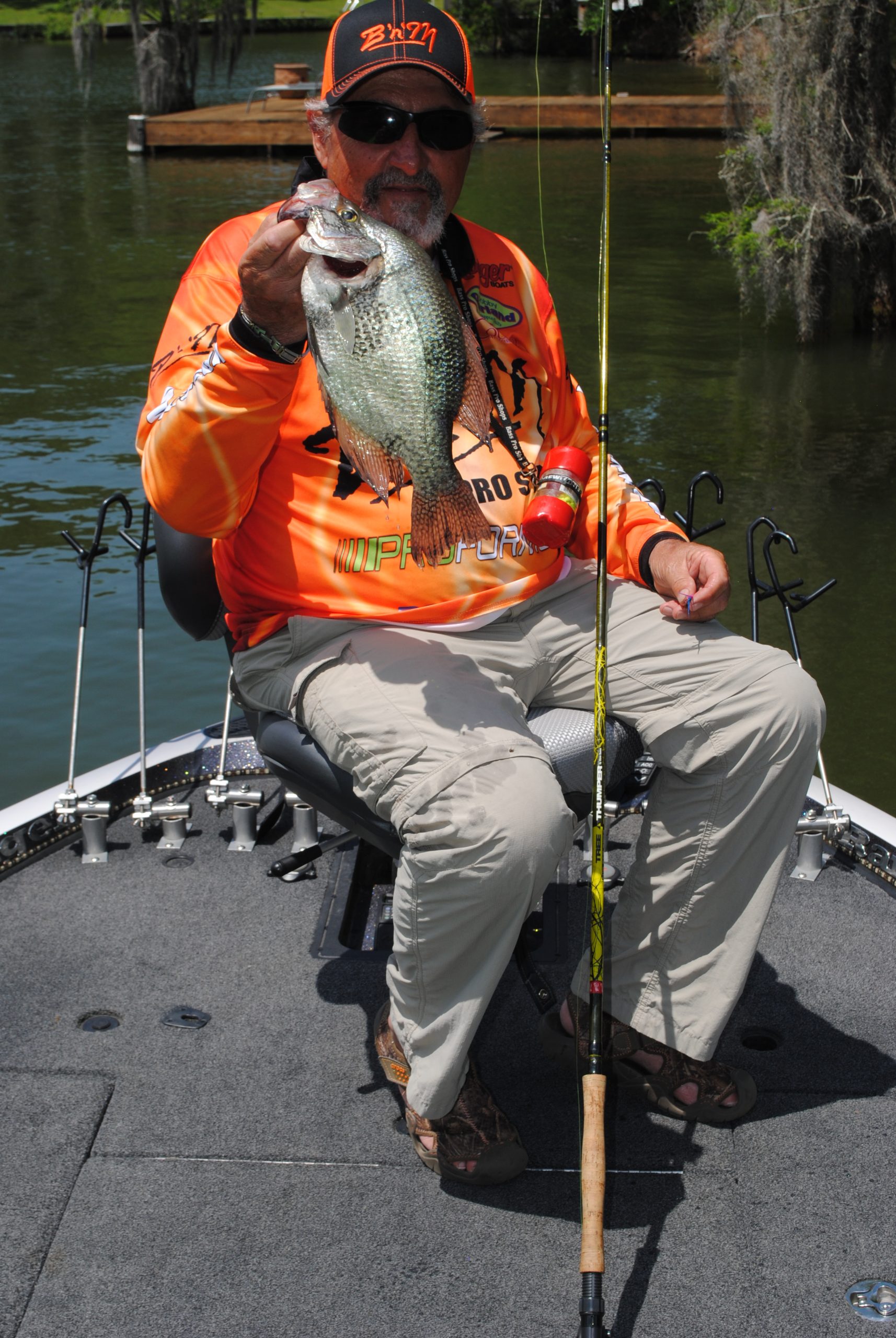The Best Crappie Rod For One Pole Fishing
Mention single pole crappie fishing, and many seasoned fishermen scoff at the notion. In particular, tournament competitors like their chances of cashing a check when some type of trolling technique produces money fish. Admittedly, the various iterations of multi-rod trolling are an ultra-efficient means of crappie fishing. Simply based on sheer numbers, putting more lures in the water probably means more crappie. An eight rod spread across the front of a boat, with the potential of more lines out the side or the back, will catch more fish than even the best crappie rod for jigging, given the right conditions.
Yet, those situations exist when trolling is not an option. Fishing conditions, particularly around gnarly wood structure, negates the opportunity to spread rods in every direction. A streamlined, one-rod approach can be more effective in standing timber, in a crowded stump field, and even in open-water areas filled with shallow treetops.
Other fishermen are particularly blunt about what they view as the monotonous nature of watching a spread of rods. A common refrain is “I hate trolling.” Some fishermen are even perfectly willing to sacrifice numbers for the pure joy and adrenaline rush of “feeling the thump.”

Gerald Overstreet casts for Alabama River crappie using the B’n’M SharpShooter Six rod.
“It’s definitely one of the reasons I like to fish with a single rod at times,” said tournament veteran and crappie guide Gerald Overstreet. “There’s nothing quite like feeling that thump.”
Overstreet and most other tournament competitors concede the need to troll at times, and he and tournament partner Steve Brown will almost always be found with a rack of B’n’M trolling rods in the boat. Even then, a common practice for Overstreet and Brown is to deploy seven rods and preserve the final pole in an eight-rod tournament maximum for strategic employment in select spots.
While there are many possibilities for your one crappie fishing pole and dock shooting and traditional “cork and minnow” presentations come to mind, the following are three definite possibilities when a single rod suffices. Practicing one of these approaches works on most crappie fisheries and serves as a viable option year round.
Best Crappie Rod: The Classic One-Pole Presentation
Most knowledgeable crappie fishermen associate single crappie pole fishing with a particular presentation. They use a long crappie jigging pole up to about 11 feet long and vertical jig around some type of structure.
The technique can be deadly when crappie are located in dense wood structure that does not allow for trolling. An expert with one pole can quickly put a limit of slabs in the boat, dialing in on such features as the depth fish are holding, the speed of the drop of the lure, even the best side of a structure to fish.

Gerald Overstreet often catches better quality crappie along the Alabama River when he changes from trolling to a one-pole approach.
“Sometimes, it’s just like trolling,” said Mike Vallentine, owner of CrappieMasters and one of the most passionate one-pole advocates in the industry. “The fish will tell you what they want. Based on your electronics, you know the fish are there. They might not like the drop rate of a bigger jig, but quickly changing to a smaller jig, and it’s not time-consuming like changing out an entire spread of trolling rigs and it will produce immediately.
“Maybe it’s a situation on a bright, sunny day, and all the fish are holding on the shady side of standing timber. It’s hard to pinpoint those fish, but you can hit the exact spot with a single crappie jigging pole,” Vallentine pointed out.
In his tournament travels with Crappie Masters, Vallentine rarely finds a venue where one-pole fishing is not productive. Because his fishing time is usually limited during tournaments, he also wants a technique that is not time-consuming.
“There’s nothing I like better than having one crappie jigging pole on my deck and knowing that it will produce,” Vallentine said. “That’s why I like one-pole fishing. Anyone who trolls will tell you they need a lot of time, sometimes as much as an hour, to get ready. Breaking off is a common occurrence when trolling, and re-rigging takes time.
“With just one pole, you can break off a jig, re-tie, and be back to fishing in less than a minute,” Vallentine added.
Vallentine one-pole fishes with Ozark Rods Pro Series poles. He pitches, flips, and vertically drops lures to exact locations with practiced ease.
“Varying your presentation is one thing to consider when single pole crappie fishing. Sometimes I just strictly fish vertically. Other times, I will flip past a piece of structure and allow the jig to pendulum past the spot holding fish,” Vallentine said. “You can learn to judge the drop rate of a jig and get to that exact sweet spot with a short flip or pitch.”
According to Vallentine anglers can also fish the entire water column easier with a one-pole approach. He gives an example of fish that are holding at eight feet but want the lure one to two feet above them and it is much easier to make that lure presentation with a single rod.
Guide Brad Whitehead practices the classic one-pole approach on Tennessee River lakes and also on the Bear Creek Development Authority lakes in northwest Alabama.
His rod of choice is a B’n’M 7 ½-foot Crappie Wizard. Because the water he fishes is generally deep – up to 30 feet on Pickwick and Wilson lakes – he usually fishes jigs up to ¼-oz. and pairs them with Crappie Magnet plastics.
“There are a few things you can do with these rods,” Whitehead said. “You can toss it or flip it and let it fall. That looks like a dying threadfin shad, and that approach can work, but I like the straight-down presentation. The boat movement will make this bait look natural. That’s usually all the movement that you need to trigger a strike.”
Best Crappie Rod: Pitchin’ and Flippin’
Louisiana angler Steve Danna is one of the iconic figures in the crappie fishing world. The ProFormula and B’n’M pro is rarely happier than when pitching a jig around cypress trees with his signature rod series on his home waters, Lake D’Arbonne in the northern part of the state.
“It’s not one of those things that will work year-round, but it’s certainly a technique that I practice from pre-spawn until well into the summer,” Danna said. “Even in the hot summer months, there will still be males guarding fry in shallow water.”
After years of refining the technique, Danna designed his own rod with the help of the staff at B’n’M. The result is a product well suited to Danna’s pitching prowess. The Steve Danna Tree Thumper, available in 10- and 11-foot models, is a perfect blend of sensitivity and power.

Louisiana crappie pro Steve Danna catches fish shallow around cypress trees from pre-spawn well into the summer months.
Danna works all sides of cypress trees, abundant on lakes like D’Arbonne and others around the Southeast, first pitching a jig past his target and allowing the lure to swing back past the structure. Once the jig has completed its arch, Danna works it vertically a couple of times and then quickly moves to his next target.
“I can pitch and cover a single tree quickly,” Danna said. “The key is finding that tree that is holding the most and the best crappie.”
Danna usually works water from about two to five feet deep. The shallow water allows him to use a light jig, usually 1/32nd oz., that produces a slow, tantalizing fall. He ties most of his own hair jigs, many in colors that mimic crawfish, which serve as a primary forage on D’Arbonne.
“I can get that jig into spots that you couldn’t possibly reach trolling or even casting,” Danna said. “It’s something I like to do, and I find it effective just about anywhere that I fish that has a population of shallow crappie.”
Best Crappie Rod: Old-School approach
Overstreet encounters plenty of situations where an old-school casting approach works well for him on Alabama River impoundments. In particular, he can target shallow or mid-depth crappie down to about 12 feet with a varie ty of casts, flips, or even vertical presentations.
He executes all of the above with an unusual rod choice, the B’n’M SharpShooter Six, designed for dock shooting but equally applicable to casting situations. The SharpShooter Six is a little stiffer than the original, ultra-limber SharpShooters.
“It works well casting,” Overstreet said. “I still like the flexibility of it, which allows me to cast even the lightest of jigs.”

Louisiana crappie pro Steve Danna drags a slab away from the knees of a cypress tree, a common location for him to target slabs.
Overstreet uses B & B weedless hair jigs or TTI-Blakemore Road Runner heads equipped with Midsouth plastics.
“I’m going to troll when the situation calls for it,” Overstreet said, “but even in tournament situations, I catch plenty of key fish casting. I also like to cast when I’m just fun fishing, and I also have clients who just don’t want to troll.
“I’ve got plenty of tops up and down the Alabama River that I can cast to and catch lots of crappie.”
Overstreet runs to one of the many treetops or stumps that he has marked on the river. He scans the area with his Garmin Panoptix LiveScope electronics and determines the number and even the quality of the fish holding there.
“I can see where the fish are holding using the LiveScope,” Overstreet said. “I’ll back off just a little bit, cast past the stump or top, and then inch that lure back over the top, hoping to hit the sweet spot. You can’t really duplicate that presentation by trolling.”

Focusing in on one pole and not just trolling for crappie can produce some genuine, satisfying results.
Often, particularly in areas with little or no current, the fish will scatter around structure. In those scenarios, Overstreet makes random casts of his crappie jigging pole to dissect an area. His retrieve is usually slow and steady with occasional stops or subtle hops of the lure.
“They’ll hit at just about any time,” he said. “Sometimes it’s on a straight retrieve and other times on the fall. It’s a thrill to feel the thump and to see that line jump.
“It’s also fun to play the fish back to the boat as opposed to simply lifting them while vertical trolling.”
Best Crappie Rod: Blending Techniques
The time sometimes arrives on tournament day when Overstreet and Brown realize that their trolling presentations are just not producing the numbers and quality desired. A frequent change is to reduce the number of trolling rods to six or seven and use the shorter crappie jigging pole or casting rods to target select locations.
One such occasion occurred several years ago in a Crappie Masters tournament on the Alabama River. The team quickly caught limits both days of the tournament but were never satisfied with the weight.
“Both days, we started single pole crappie fishing, putting one trolling rod in the rack because you can only use eight rods total, and began to catch a better quality fish,” Overstreet explained. “It’s not something we do all the time, but there are those times when a little change-up helps.
“We didn’t want to quit trolling, but the single rod produced key fish both days and improved our weight.”

Steven Danna expects him new signature rod, the B’n’M’ Tree Thumper, to produce plenty of crappie like this one.
The result was a better finish that allowed Overstreet and Brown to inch up the standings and to earn a check.
“We knew the areas we were fishing, and the single pole allowed us to pinpoint portions of structure that we might not reach trolling. In some situations, you might troll past a stump and the trolling lures just don’t hit that sweet spot,” Overstreet explained. “We can take the single crappie jigging pole and hit either side or the front and back, maybe give the fish a little more time to see a lure than would be the case with trolling,”
The approaches to a livewell full of crappie are many and varied. Trolling is certainly effective. However, don’t dismiss the notion of a single rod crappie jigging pole. Add to your crappie arsenal with any one of these single-pole approaches. They all work.
This article first appeared in the August 2019 print issue of Great Days Outdoors Magazine. For more great hunting and fishing content for the deep South, subscribe to Great Days Outdoors print and digital editions or click the image to download this issue.

